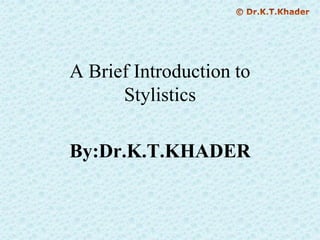
Intro to-stylistics
- 1. A Brief Introduction to Stylistics By:Dr.K.T.KHADER
- 2. What Is Stylistics? Stylistics is the science which explores how readers interact with the language of (mainly literary) texts in order to explain how we understand, and are affected by texts when we read them.
- 3. Stylistics is the scientific study of style, which can be viewed in several ways. More technically, stylistics is the study of the linguistic features of a literary text _ phonological, lexical, syntactical _which directly affects the meaning of an utterance. The variety in stylistics is due to the main influences of linguistics & literary
- 4. Stylistics, then, is a sub-discipline which grew up in the second half of the twentieth century: It’s beginnings in Anglo-American criticism are usually traced back to the publication of the books listed below: Fowler, Roger, Essays on Style in Language.
- 5. Freeman, Donald, Linguistics and Literary Style. Leech, Geoffrey, A Linguistic Guide to English Poetry. Sebeok, Thomas , Style in Language.
- 6. These books are collections of articles, some of which were either: 1_ Conference papers OR 2_Articles published in journals.
- 7. Perhaps the most influential article is: (Closing statement: Linguistics and poetics) By Roman Jacobson who is an important figure who contributed in the development of Stylistics.
- 8. Therefore ,stylistics is concerned with the examination of grammar, lexis, semantics, as well as phonological properties and discursive devices .It might seem that the same issues are investigated by sociolinguistics , and indeed that is the case, however sociolinguistics analyses the above mentioned issues seen as dependant on the social class, gender ,age ,etc , while stylistics is more interested in the significance of function that the style fulfills
- 9. Stylistics examines oral and written texts in order to determine crucial characteristic linguistic properties, structures and patterns influencing perception of the texts. Thus, it can be said that this branch of linguistics is related to discourse analysis , in particular critical discourse analysis , and pragmatics. Owing to the fact that at the beginning of the development of this study the major part of the stylistic investigation was concerned with the analysis of literary texts it is sometimes called literary linguistics, or literary stylistics.
- 10. Nowadays, however, linguists study various kinds of texts, such as manuals, recipes, as well as novels and advertisements . It is vital to add here that none of the text types is discriminated and thought to be more important than others .In addition to that , in the recent year so called ' media-discourses' such as films, news reports, song lyrics and political speeches have all been within the scope of interest of stylistics.
- 11. The Development of Stylistics The development of Stylistics, given that it combines the use of linguistic analysis with the psychological processes involved in reading.
- 12. In the twentieth century Stylistics can be seen as a logical extension of moves within literary criticism to concentrate on studying texts rather than authors. While in Nineteenth century literary criticism concentrated on the author, and the text-based criticism of the two British critics Richards and William Empson who rejected that approach and replaced it with the other approach called Practical criticism.
- 13. In many respects , however , stylistics is close to literary criticism and practical criticism . by far the most common kind of material studied is literary , and attention is largely text– centered .
- 14. Practical criticism concentrates on the literary texts themselves, and how readers were affected by those texts. In addition Practical criticism is matched by a similar critical movement in the USA called New criticism.
- 15. What is New Criticism? New Criticism is based on the description of literary works as independent aesthetic objects.
- 16. Practical Criticism and New Criticism share two important features: 1_An emphasis on the language of the text rather than it’s author. 2_An assumption that what criticism needed was accounts of important work of literature based on the intuitional reading outcomes of trained and aesthetically sensitive critics.
- 17. Although both practical and new criticism pay too much attention to the effect of the text on the readers, yet from the stylisticians point of view, it is not enough to criticize a text because intuition is not enough and we must analyze the text in detail.
- 18. Roman Jacobson who is a member of the Russian Formalists is one of the most influential linguists on stylistics for two reasons: 1_For his academic brilliance. 2_Because he linked various schools of linguistics together.
- 19. Roman Jacobson moved from Moscow to Prague and joined the Prague Structuralists Circle who were interested and affected by his views. Later he moved to the USA where he carried his approach with him, which is now called STYLISTICS.
- 20. Types of Stylistics: Stylistics is sometime called confusingly literary stylistics or linguistic stylistics. Linguistic stylistics the purest form of stylistics in that its practitioners attempt to derive from the study of style and language variation
- 21. The most recent studies in linguistic stylistics have tended to focus on applications of studies in discourse analysis and narrative organization to literary text study.
- 22. Burton (1980,1982)employs models for spoken discourse analysis based on Sinclair and Coulthard (1975)for the analysis of drama dialogue Short (1981) use analysis based on Gricean and speech act theory. Carter and Simpson (1982) use narrative models based on Labov (1972). Fowler (1981; 1982) exploits Hallidayan models from within systematic linguistics
- 23. Literary stylistics: established methods of close reading or practical criticism of texts, the procedures of literary stylistics remain traditional in character in spite of development in literary theory (e.g. post - structuralism) which challenge assumptions about the role of language in depicting literary realities .